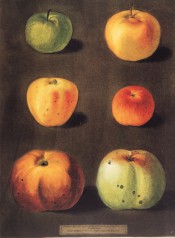Malus domestica ‘Newtown Pippin’
‘This variety, when perfectly matured, is considered by some the finest apple in our country; its skin is green, changing to olive yellow at maturity, having a thin russet covering the greatest part of the base; flesh pale yellow and firm; juice sacharrine, and possessing a rich and highly aromatic flavour: from December to April.’ [FCM p.44/1845].
Horticultural & Botanical History
Fruit; large, roundish, broadest at the base, ribs flat, but terminating prominently on the crown. Skin; green, becoming yellowish green, light brown next the sun. A dessert apple. ‘One of the finest apples in the world when grown in a suitable climate, but in (Britain) it requires a wall.’ [Proc. RHS1862-1865]. Figured in Pomona Brittanica [PB pl.93/1812]. ‘Newtown Pippin’ is the apple at bottom right.
‘This is an old American apple. It originated at Newtown, on Long Island, U.S., and was introduced to this country about the middle of the last century. I find it was cultivated in the Brompton Park nursery so early as 1768, under the name of “Newtown Pippin from New York.” Forsyth remarks that it is said to have been originally from Devonshire, but if it were so, there would still have been some trace of it left in that county. It is extensively cultivated in New York, and all the middle states, and particularly on the Hudson, where the finest American orchards are. There are immense quantities produced which are packed in barrels and exported to Britain and other parts. The month of January, is generally the season they arrive in this country, and then they are the most attractive of all dessert apples in Covent Garden market; the name serving in many instances, as a decoy for the sale of many other and inferior varieties. The Alfriston, in many collections, is erroneously cultivated under the name of Newtown Pippin.’ [Hogg p.143/1851].
‘A large round green fruit, an excellent apple.’ [David Crichton. NSW Hort. Mag. vol.1 p60/1864].
History at Camden Park
Listed in the 1850 and 1857 catalogues [Apple no.45/1850]. Probably obtained from George Stevenson, South Australia, in 1844. [MP A2933-1, p.21/1844].
Notes
Two types of ‘Newtown Pippin’ were recognised in North America. This review of the history of the ‘Green Newtown Pippin’ and ‘Yellow Newtown Pippin’ is from the Apples of New York. ‘The excellent historical account of the Yellow Newtown and the Green Newtown given by Taylor is reproduced here:
The “Newtown Pippin ” was the first American apple which attracted attention in Europe. After the receipt of specimens by Franklin while in London in 1759, and the subsequent sending of grafts to Collinson by John Bartram, numerous attempts were made to grow the variety in England. As early as 1768 it was cultivated in the Brompton Park nursery under the name “Newtown Pippin of New York.” It is probable that the large apple exports of 1773 included considerable quantities of the Newtown, for it was at that time quite generally distributed through the apple-growing districts of the Atlantic slope. Thomas Jefferson recorded in his “Garden Book” that in March, 1773, grafts of “Newtown Pippin,'' received from Mordecai Debnam, at Sandy Point, were “ingrafted by P. Morton,” and in March, 1778, he noted that the grafted trees were planted out at Monticello.
Prior to 1803 Forsyth said of the variety in England, “The New-Town Pippin is a fine apple in good season, but seldom ripens with us. It is held in great esteem in America.” McMahon, in 1806 included Newtown Pippin in his select list of “Long-keeping apples” and also in a list of “Cyder apples.”
Previous to 1817 we have no record that more than one type of the Newtown was recognized, but Coxe, whose work appeared in that year, described as distinct varieties the “Large Yellow Newtown Pippin” and the “Green Newtown Pippin,” characterizing the latter as “a variety of the preceding kind.” Since the time of Coxe the two types have been recognized as distinct by our leading American pomologists, though fruit growers are by no means unanimous on this point.
The original seedling tree of Newtown Pippin is alleged to have stood near a swamp on the estate of Gershom Moore, in Newtown, Long Island, until about 1805, when it died from excessive cutting of cions [sic] and exhaustion. Its origin is credited to the early part of the eighteenth century. It is not clear at this time whether the original tree was of the “green” or the “yellow” type, nor has any record of a distinct origin of the two been discovered. The Yellow Newtown has for many years been considered the better apple for exportation, however, and in commercial orchards has almost superseded the Green Newtown on account of its larger size, brighter color, and better keeping quality.’ [Apples of New York vol.1, p.147/1905].
Published Apr 16, 2010 - 02:15 PM | Last updated Jul 25, 2011 - 03:24 PM
| Family | Rosaceae |
|---|---|
| Category | |
| Region of origin | Garden origin, USA |
| Synonyms |
|
| Common Name | Apple, Dessert apple, Keeping apple |
| Name in the Camden Park Record |
Newtown Pippin |
| Confidence level | high |


